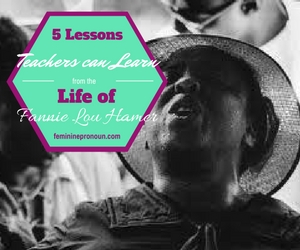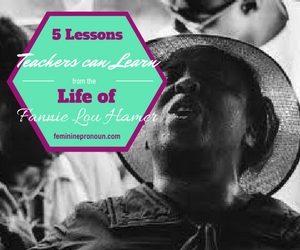
At a recent presentation, I talked about five lessons teachers could take from the life of Fannie Lou Hamer. In response to my assertion that the ability to speak or write in Standard English was not an indication of intellect, an audience member said the following: “Speaking and writing in standard English is not proof of intellect. It is just proof that you have mastered the dominant dialect.”
This also reminded of the story of W.C. Fields, who upon meeting a young Chinese child remarked, “How’d you learn Chinese so young?”
The two remarks, one from the audience member and one from the great vaudevillian comedian, both speak to similar points. First, language acquisition happens young, is often intuitive, and as such has very little to do with “intellect,” and many smart adults find it difficult to write and speak in a different language.
Right now there is an adult somewhere struggling to learn Farsi, while a young child in Afghanistan is moving fluidly through the dialect without being conscious of acquiring a large and dexterous vocabulary.
For those of us who teach in the US, it might be instructive to think of native students for whom standard (US) English writing does not come easy, the same way we look at students who struggle with learning to speak and write a new language.
In the case of Fannie Lou Hamer, the gifted organizer, orator, and thinker, (who did not speak in standard English), when she was “discovered” by young activists in the student nonviolent coordinating committee, we can be certain that these college educated, trained organizers saw Mrs. Hamer as someone with only a modicum of gifts to offer the civil rights movement. After all, the head of their organization, James Farmer, as well as the nation’s spiritual and intellectual “head” of the civil rights movement, Martin Luther King Jr, were both college-educated men from bourgeoisie backgrounds.
The shear level of Jim Crow segregation in Mississippi had created a “country within a country.” The residents spoke with a deep southern dialect, and were often illiterate. Mrs. Hamer was not illiterate. Quite to the contrary, she was an avid reader of the Bible, and was quite known for her remarks in church, as well as her beautiful, throaty alto voice. She had not, however, moved past the equivalent of middle school.
She was very much like our present day immigrant students who have been honor students in their home countries, or for those of us who work with immigrants adults, who have been at the top of their professions in their home countries.
Mrs. Hamer spoke like her constituency. Mrs. Hamer wrote at the level of her constituency. Her quality of thought, however, belied a deep intellectual gift, that became apparent to the SNCC organizers after they spent just a little time with her.
For many black and brown students who are native English speakers, but still struggle with writing in standard (US) English, the same parallels can be drawn. Being able to write in Standard English is one area of evaluation in their lives that most of the stakeholders in their communities don’t even know about. Many young black and brown people come to the classroom known for being artisan hair braiders, fantastic family mechanics, good with the children in their family, excellent caregivers of elderly grandparents, sought after spoken word artists, and natural mediators.
Like Fannie Lou Hamer, they come to the table with a community’s worth of support, and a community level expertise that can be channeled to help them meet challenges and accomplish goals.
These truths make the devaluation of certain intellects in writing classrooms very troubling, because the value Mrs. Hamer brought to the movement is undeniable, and had she been written off like many of the students in our classrooms, the world would be much poorer for it.
What young people in SNCC did was invite Mrs. Hamer into the decision making process. They also used her translating skills to share ideas with the members of her community. Finally, they shared their training with her in the spirit of peers and collaborators, not as paternalistic saviors.
Talk to text technology, graphic novels, and authors and images that reflect the culture of the student are just a few of the techniques that can uncover the skills students must display to prove mastery.
As a result of taking this stance, what did SNCC, nay, the world receive in return from Mrs. Hamer? We received a rare intellect able to cut through distraction straight to action. We received a brave advocate for blacks, women, poor folks, southerners, children, and labor. We received proof that like Mrs. Hamer, the “exceptions” we’ve met in the classroom are only the tip of the iceberg, and that if we listen to them, they will lead us to the rich truths that have sat hidden from sight for too long.
_________________________________________________________________________

